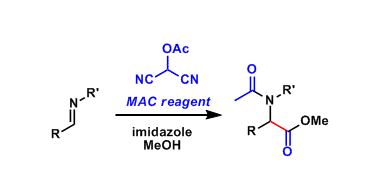Overall Score4
- Generality
- Reagent Availability
- Experimental User Friendliness
-
General Characteristics
Dicyanomethyl acetate, known as MAC (Masked Acyl Cyanide) reagent, is an acyl anion equivalent used for one-carbon homologation of aldehydes and imines. This reagent can be viewed as an equivalent of carbon monoxide. It is acidic enough to be used under weakly basic conditions.
-
General References
- Nemoto, H.; Kubota, Y.; Yamamoto, Y. J. Org. Chem. 1990, 55, 4515. DOI: 10.1021/jo00302a008
- Nemoto, H.; Li, X.; Ma, R.; Suzuki, I.; Shibuya, M. Tetrahedron Lett. 2002, 44, 73. doi:10.1016/S0040-4039(02)02483-8
- Nemoto, H.; Li, X.; Ma, R.; Suzuki, I.; Shibuya, M. Tetrahedron Lett. 2003, 44, 73. doi:10.1016/S0040-4039(02)02483-8
- 根本尚夫, 有機合成化学協会誌, 2004, 62, 347.
- Nemoto, H.; Kawamura, T.; Miyoshi, N. J. Am. Chem. Soc. 2005, 127, 14546. DOI: 10.1021/ja054010h
-
Reaction Mechanism
-
Examples
One pot synthesis of peptide mimetics: MAC can be used to connect two fragments (nucleophilc and electrophilic) on each side of C=O in one pot.

-
Experimental Procedure
-
Experimental Tips
-
References
-
Related Reactions
-
Related Books
-
External Links
根本尚夫 (Prof. Hisao Nemoto’s Laboratory at Tokushima University)

